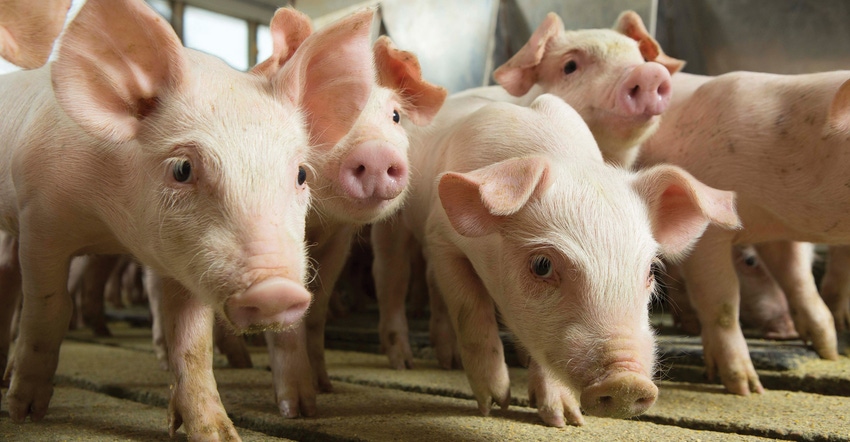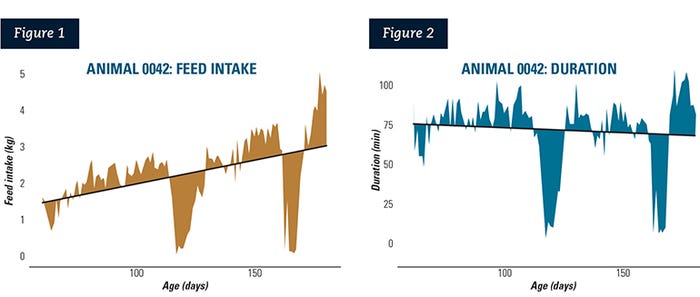Novel phenotypes related to disease resilience
Feed intake data are examined to find traits most favorable for surviving commercial health challenges.
January 13, 2020

A 2014 Journal of Animal Science paper showed mortality has the highest impact on profitability in the wean-to-finish sector in Australia. In total, it was estimated that 44% of the selection index for a terminal-sire genetic line should be devoted to postweaning survival.
Other research has estimated that only 70% of the productivity in a stress-challenged commercial environment is realized compared to a healthy, less limiting environment — such as nucleus farms for genetic suppliers.
However, geneticists say if the industry can close this 30% gap between the productivity potential and commercial production, input costs can be reduced, maximizing producer efficiency. Development of resilience traits with precision swine technology, such as individual feed intake stations, could be part of the solution to reduce the overall economic impact of negative factors such as disease and heat stress.
Researchers at Iowa State University, along with the Centre de Développement du Porc du Québec Inc., recently set out to extract novel phenotypes related to resilience using daily feed intake data (since pigs tend to eat less when they become ill) from growing pigs under a multifactorial natural disease challenge that was designed to mimic a commercial environment with high disease pressure, which would maximize expression of resilience.
The objectives of this study were to: develop and evaluate novel measures of resilience based on daily feed intake and feeding duration data for finishing pigs in a health-challenged environment; and determine heritabilities and genetic correlations of these measures with mortality, treatments and other economically important production traits.
Disease pressure
The study involved 1,341 crossbred wean-to-finish pigs from a facility in Québec, Canada. The natural challenge was established under careful veterinary oversight by seeding the facility with diseased pigs from local health-challenged farms, targeting various viral and bacterial diseases, and maintaining disease pressure by entering batches of 60 to 75 pigs in a continuous flow system.
The natural challenge facility consisted of three consecutive phases: first, a healthy quarantine nursery for around 19 days after weaning; second, a late nursery phase, where pigs are first exposed to disease for around four weeks; and third, a finishing phase for the remainder of the growing period (69 to 181 days of age on average).
The following viruses used in the challenge facility were porcine reproductive and respiratory syndrome virus (three strains), Influenza A virus of swine (two strains), porcine circovirus type-2 and porcine rotavirus A.
Bacterial pathogens diagnosed included: Actinobacillus pleuropneumoniae, Mycoplasma hyopneumoniae, Streptococcus suis, Haemophilus parasuis, Brachyspira hampsonii, Salmonella sp., Cystoiso-spora suis (coccidiosis), Ascaris suum, Erysipelothrix rhusiopathiae, and Staphylococcus hyicus (causative agent for exudative epidermititis).
To maintain acceptable levels of animal welfare and morbidity, individual treatments were given on a case-by-case basis, as were periodic batch-level (or mass) treatments.
Data collected
Four phenotypes were extracted from the individual daily feed intake data during finishing as novel measures of resilience. The first two were daily variability in FI or FI duration, quantified by the root mean square error from within individual regressions of FI or duration at the feeder on age. The other two were the proportion of off-feed days, classified based on negative residuals from a 5% quantile regression (QR) of daily feed intake or duration data on age across all pigs.
All data and samples were collected by trained research staff from CDPQ following established protocols. Body weights were taken about every three weeks. Feed intake data were recorded in the finishing phase using feeding stations. Feed was available ad libitum throughout the study.
All treatment and mortality events and reasons were recorded. Main treatment reasons included respiratory distress (thumping); gray or brown scours; coughing; lameness; yellow scours; arthritis; and failure to thrive or poor or skinny or hairy.
Main mortality reasons included failure to thrive or poor or skinny or hairy, thumping or heavy breathing, sudden death, meningitis, and lameness or arthritis. Virtually all treatment reasons and 89% of the mortality reasons were disease-related.

Resilience results
The resilience traits that were derived from individual daily feed intake data showed low to moderate heritabilities, and moderate to strong genetic correlations with mortality and treatment rate.
Genetic correlations production traits tended to be low for the root mean square error (RMSE) measures of resilience, but higher for the QR measures.
Mortality and treatment rate had a heritability of 0.13 (±0.05) and 0.29 (±0.07), respectively. Heritability estimates for RMSEFI, RMSE duration at feeder, QR FI and QRDUR were 0.21 (±0.07) 0.26 (±0.07), 0.15 (±0.06), and 0.23 (±0.07), respectively.
Genetic correlations of RMSE and QR measures with mortality and treatment rate ranged from 0.37 to 0.85, with QR measures having stronger correlations with both. Estimates of genetic correlations of RMSE measures with production traits were typically low, but often favorable (e.g., −0.31 between RMSEFI and finishing ADG).
However, the researchers say the genetic correlations reported may underestimate true correlations. This is due to the initial challenge period being missed, because pigs were first challenged in the nursery, feed intake data for RMSE and QR were recorded in the finishing unit only, and mortality and treatments were recorded over the entire wean-to-finish period.
Also, even though disease resilience was the target, fluctuations in FI and duration can be caused by many factors, including disease, heat stress, handling and social interactions.
Thus, the measures of resilience investigated here are still “black-box” phenotypes and should be viewed as general resilience instead of the narrower concept of disease resilience.
Commercial conditions
In conclusion, genetic suppliers typically select replacements in high health environments, creating a need to collect resilience data in commercial conditions and these data then go back to the purebred animals for final selection.
However, the only practical trait available for genetic suppliers to select for, to date, has been mortality. This trait is very lowly heritable, leading to progress being made extremely slowly over time.
Novel resilience traits, such as those presented in this article, can be added to the selection index for added accuracy and response to selection in commercial environments.
This research expands resilience to negative factors such as heat stress and could potentially be implemented in a breeding program to reduce the economic losses realized in wean-to-finish production.
Researchers: Austin Putz and Jack Dekkers, Iowa State University; John Harding, University of Saskatchewan; Graham Plastow and Michael Dyck, University of Alberta; Frédéric Fortin, Centre de Développement du Porc du Québec Inc.; and PigGen Canada. Contact Putz.
You May Also Like



